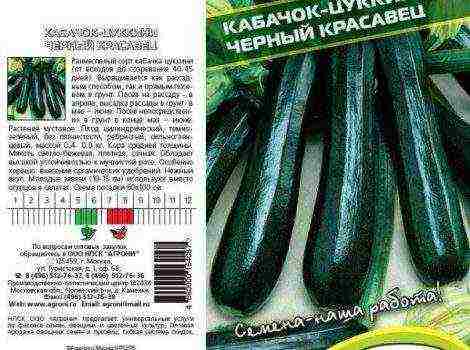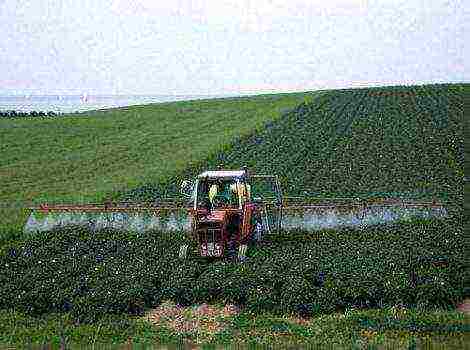Content
- 1 11 most dangerous zucchini diseases
- 1.1 The most common zucchini diseases
- 1.1.1 Anthracnose (copperhead)
- 1.1.2 Ascochitosis
- 1.1.3 Bacteriosis or angular leaf spot
- 1.1.4 Vertex bacteriosis
- 1.1.5 Dry top rot
- 1.1.6 Treatment of seedlings from fusarium wilting
- 1.1.7 Powdery mildew
- 1.1.8 When leaves turn yellow or peronosporia
- 1.1.9 White rot
- 1.1.10 Brown olive spot
- 1.1.11 Viral diseases
- 1.2 Protection against diseases and pests
- 1.1 The most common zucchini diseases
11 most dangerous zucchini diseases
Many gardeners can boast of good yields of courgettes. Indeed, the agricultural technology of a vegetable is simple. Meanwhile, there are many diseases that affect the plant. Why you should not ignore external signs and what to do for the timely treatment of a particular disease, we will now analyze in detail.
The most common zucchini diseases
Each crop in the garden has its own enemies that can destroy the entire crop. If characteristic symptoms are found, it is worthwhile to immediately carry out the treatment, and in some cases remove the diseased plant from the garden to localize the problem.
Zucchini is considered a moisture-loving culture, and when watering the garden in hot weather, a favorable background is created for the development of pathogenic bacteria and microorganisms. Almost all fungal infections are activated precisely in warmth and humidity. The main carrier of spores can be soil or seeds, therefore, before planting, the environment and seeds are disinfected.
Experienced gardeners regularly inspect plants in order to quickly identify diseases or pests in order to quickly respond to the problem that has arisen. In this case, it is much easier to localize the affected areas of plants.
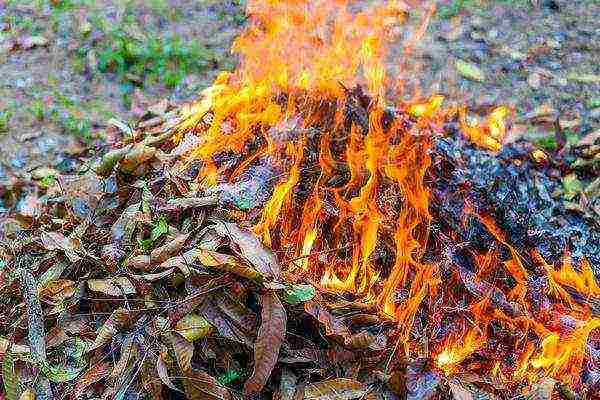
They create favorable conditions for the development of harmful microorganisms and weeds. In clean beds, spores are harder to spread than in thickened areas where a moist environment is constantly maintained. During the growing season of zucchini, 3-4 weeding are carried out, which are combined with loosening the soil. Such procedures are good prophylaxis against diseases.
Anthracnose (copperhead)
The danger of the disease lies in the affected area, which extends to all organs of the plant, with the exception of the roots. A characteristic feature is yellow-brown spots on the leaves, in other places the spots are depressed, covered with a pink coating. If spotting is seen in the root area, then the zucchini will not be able to survive.
The fight against the disease consists in careful selection of seedlings, removal of affected specimens from the garden, and timely removal of weeds. So that the spores of the disease do not pose a threat to the future harvest, in the fall all plant residues must be well removed from the site and the earth must be dug closer to frost.
When the first signs of copperhead are found, it is recommended to spray with one of the solutions:
- colloidal sulfur (50-60 grams per bucket of water);
- Bordeaux mixture (copper sulfate and lime, 100 grams per 10 liters of water).
When growing crops in greenhouses, surface disinfection should be carried out in autumn and spring. Disinfection involves the use of bleach (200 g) per 10 liters of water.
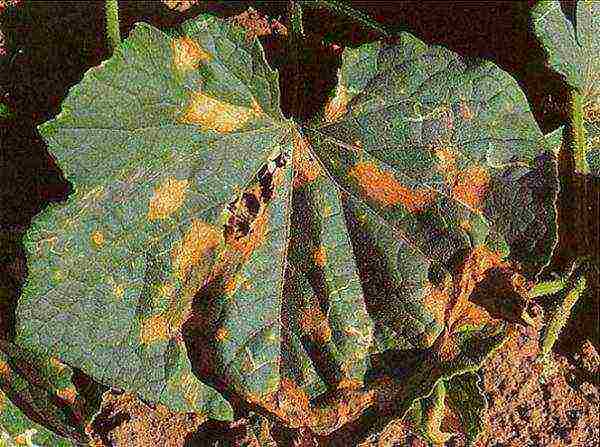
Ascochitosis
The fungal disease affects all aerial parts of the shoot and is characterized by the formation of black spots (fungi pycnidia) on the leaves and stem. Ascochitis develops quickly; with late diagnosis, the plant cannot be saved.The reason for the defeat of the culture can be spores that survived from the last season in the soil, or waterlogged soil.
When the first signs are found, it is recommended to dust the affected area with a mixture of copper sulfate and chalk (1: 1). Crushed activated carbon can also be added to the powder. This is done to dry out the tissue and isolate the problem.
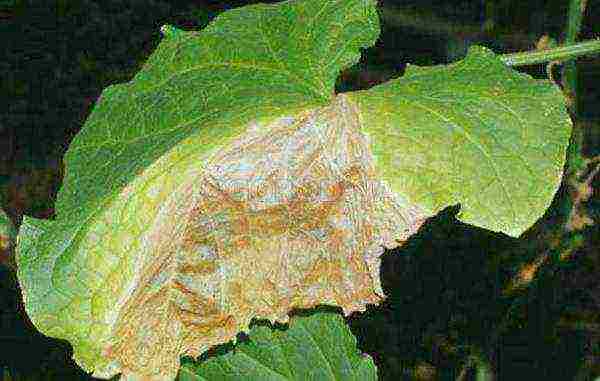
Bacteriosis or angular leaf spot
The disease is dangerous in that it affects not only parts of the plant, but also the fruits. Small brown sores form on the cotyledons, on the leaves the spots are angular. The fruits on such bushes are formed with curvatures and deformations of a different nature. At the initial stage of the disease in the morning, the spots acquire a dark green color, gradually turning into brown. A sharp change in the temperature regime provokes the rapid development of the disease, so you should not hesitate with processing.
The fight against bacteriosis includes:
- disinfection of seeds before sowing;
- annual change of the place of planting of culture;
- removal of the affected plant from the garden with subsequent disposal;
- for prevention, the bushes are sprayed with a Bordeaux mixture.
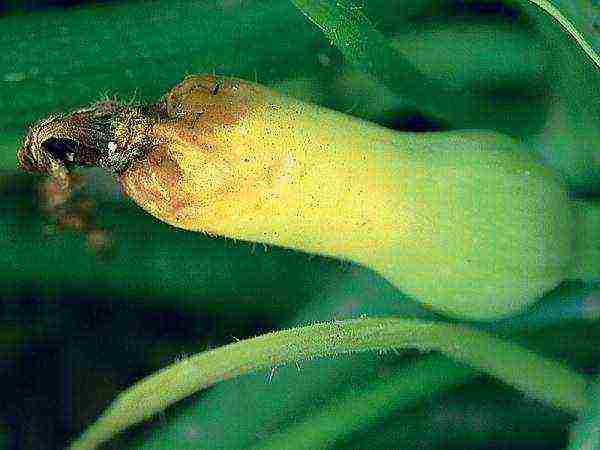
Vertex bacteriosis
Another type of fungal infection that affects the pistils and ovaries of flowers, as a result of which decay is formed, accompanied by an unpleasant putrid odor. It is easy to identify the problem - on the stems or fruits, first yellow, then brown, moist spots are formed, turning into a brown color.
When the first signs are found in the plants, damaged areas are removed or the bush is torn off the garden bed entirely to prevent the spread of infection. It is possible to fight the disease successfully with preventive measures, which include moderate watering, cleaning the garden from weeds, disinfecting seeds and soil, and maintaining crop rotation.
Dry top rot
The disease is caused by a lack of calcium in the soil. It is characterized by the same signs as the apical bacteriosis, however, it does not spread to neighboring bushes due to the absence of an infectious environment. The necrosis formed on the tissues of zucchini is a consequence of calcium deficiency, during the development of which the plant loses its ability to retain moisture.
As a preventive measure, in the fall, crushed eggshells, wood ash and other agents are introduced into the soil.
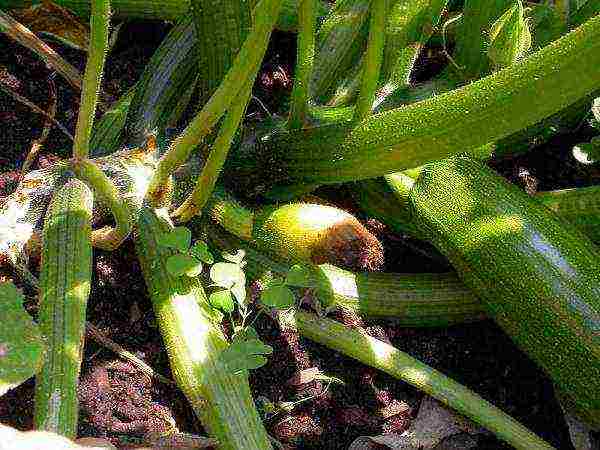
Treatment of seedlings from fusarium wilt
An insidious disease that first affects the root and vascular system of the squash. In the active phase, the foci move to the stem and leaves; it is not possible to save the shoot in the advanced stage. The danger lies in the ability to quickly spread to neighboring bushes.
When the first signs of the disease are found, healthy plants should be powdered with wood ash. If the affected area has passed to the stem and leaves, you cannot do without biological treatment. One of the most effective is Trichodermin.
A large amount of organic fertilizers introduced into the soil to increase its fertility can provoke the development of fusarium. Therefore, it is recommended to combine organic matter with minerals rich in calcium. Fungal spores do not actively develop in a neutral environment.
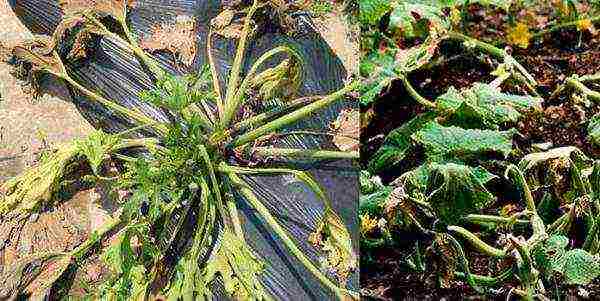
Powdery mildew
A fungal disease that draws micronutrients from a healthy plant, as a result of which the plant dies. Characteristic features: white rounded spots on the leaves, sometimes on the stem.The formed small islands eventually join together, covering the entire surface of the leaf.
At first, the greens turn brown, then dry up and roll up into a tube. The disease develops from spores that overwintered in plant residues in the garden, or as a result of a deficiency of nitrogen fertilizers.
For prevention purposes, it is recommended to follow the schedule for the introduction of fertilizers and dressings, use disinfected seeds, and fight weeds. In case of extensive damage, use special drugs: Fitosporin, Fitolavin, Gamair and other funds.
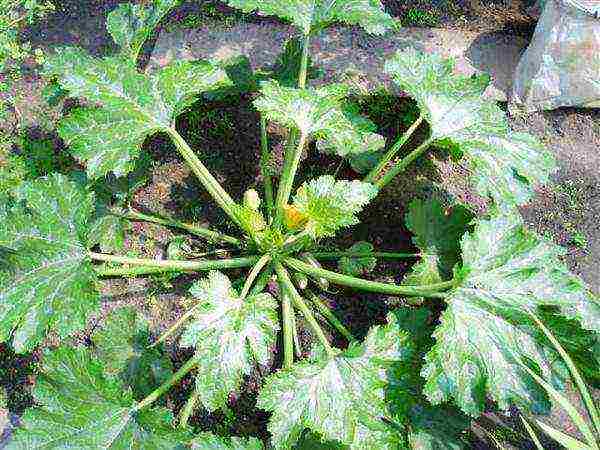
When leaves turn yellow or peronosporia
It affects the foliage of zucchini at all stages of plant development, while it begins to turn yellow and curl, yellow-green spots of an angular or rounded shape are formed. On the reverse side, a plaque of a gray or purple hue is visible, which indicates the sporulation of the fungus. In the advanced stage, the greens dries up, only the petioles remain from the bush. In a warm and humid environment, peronosporia develops quickly enough, if signs are found, the affected leaves should be removed from the squash. Treatment of phyto preparations or infusion of onion peels will not hurt.
White rot
Fungal disease affects all organs of the squash, forming white deposits. The tissues become soft and licky. The cause of the disease is waterlogging of the soil and thickening of the beds. Fungal spores are especially active during the fruiting period of the crop, so the harvest may be at risk.
For prevention purposes, it is recommended to follow simple rules:
- change the site for planting annually;
- use disinfected seeds;
- when planting, maintain the interval between the bushes;
- dust the soil with wood ash;
- regulate the amount of water for irrigation.
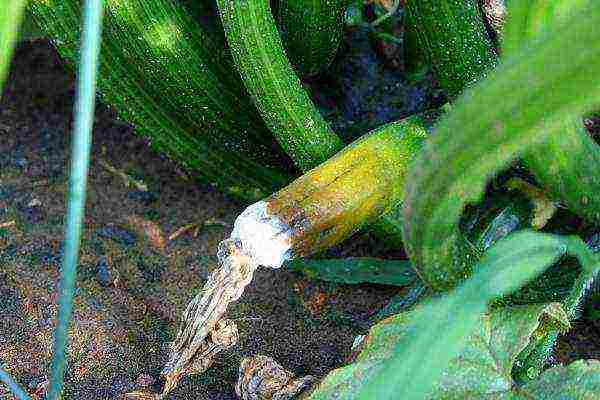
Brown olive spot
A fungal disease that affects fruits, forming watery spots on them. After a while, the zucchini will deform and rot. The outbreak can also go to leaves, on which brown spots with a light center appear. Cool, rainy weather is considered the ideal environment for the development of the fungus. If a problem is found, it is recommended to treat the beds with biofungicides. After harvesting, it is necessary to carefully remove all plant residues and disinfect the soil with special solutions.
Viral diseases
Green speckled and white mosaics are extremely dangerous due to incurability. So that the virus does not affect the harvest of the new season, they change the soil in the garden, and the plant residues are disposed of by burning.
Typical signs of the mosaic: the appearance of yellow-green spots on young zucchini leaves with their subsequent wrinkling. On the fruits, warts and various deformations are noted. At a later stage, the entire surface of the vegetable is covered with blotches. White mosaics are recognized by whitish star-shaped spots on the leaves.

Protection against diseases and pests
The agrotechnology of zucchini includes preventive measures that significantly reduce the risk of plant infection with various diseases. Among the main ones:
- use of disinfected inoculum;
- thorough cleaning of the garden at the end of the season;
- processing of the site for planting vegetables (with a solution of potassium permanganate, boiling water, and other means);
- adherence to the planting scheme to prevent thickening of the rows;
- timely weeding;
- regular watering;
- periodic inspection of the bushes;
- compliance with the rules of crop rotation.
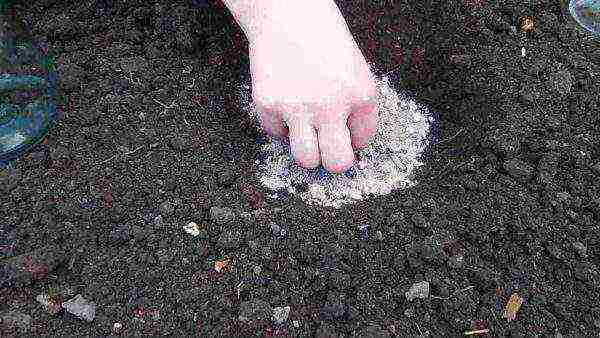
Proper preparation of the soil for sowing is also considered disease prevention.It should be enriched with nutrients (humus, peat, wood ash, compost, etc.). If the soil structure is dense, you need to introduce some sawdust, peat or rotted manure. This will make it lighter, which will allow the root system to develop normally.
With proper agricultural technology and the implementation of disease prevention, you can harvest zucchini until the very cold weather.
